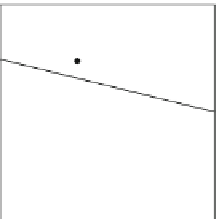Chemistry Reference
In-Depth Information
x
1
1
D
(1)
x
x
2
D
(1)
x
2
D
(7)
D
(7)
D
(6)
D
(6)
x
1
x
1
0
2
2
0
(a) N
D
7
(b) N
D
8
1
1
D
(3)
D
(2)
x
2
x
2
D
(4)
D
(3)
1
c
x
D
(2)
1
c
D
(1)
2
D
(4)
c
x
D
(7)
D
(1)
D
(7)
2
c
D
(6)
D
(6)
x
1
x
1
0
2
0
2
(c) N
D
10
(d) N
D
13
Fig. 2.14
Example 2.4; linear inverse demand and cost functions, the case of semi-symmetric
capacity constrained firms. A more detailed study of the bifurcations with respect to N. Note the
changing structure of the different regions of the map as N increases, and the border collision that
occurs as N increases from 8 to 10
As N is further increased the periodic points may cross the boundaries that sepa-
rate different regions, giving rise to border collision bifurcations that may change the
stability of the cycle involved and create new attractors. For example, in Fig. 2.14d,
obtained with N
D
13, we can see that the periodic point c
2
has crossed the bor-
der, moving from region
.4/
. However this border collision did not cause a
change of stability of the 2-cycle, because after the border crossing the two periodic
points are in regions
.1/
to
D
D
.7/
, so the 2-cycle remains stable with its multipli-
ers given by
1
.C
2
/
D
.1
a
1
/
2
,
2
.C
2
/
D
.1
a
2
/
2
.4/
D
and
D
(the two Jacobian matrices
J
.4/
D
J
.7/
are triangular matrices). Nevertheless, in the bifurcation diagram of
Fig. 2.13 the occurrence of this border crossing can be easily detected around the
value N
'
12:7.
Example 2.5.
In this example we return to the case of a quadratic price function
A
Q
2
p
A;
if 0
Q
if Q>
p
A;
f.Q/
D
0

























Search WWH ::

Custom Search